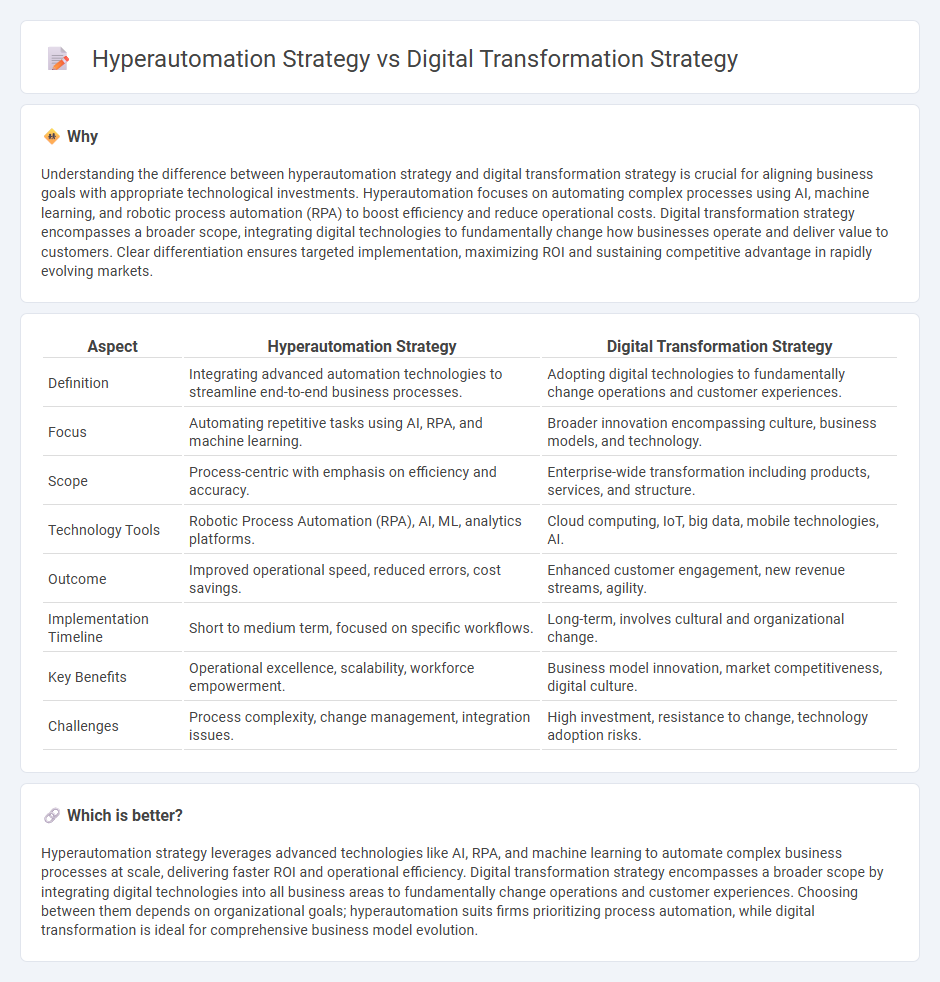
Hyperautomation strategy leverages advanced technologies like AI, machine learning, and RPA to automate complex business processes, enhancing operational efficiency and agility. Digital transformation strategy encompasses a broader scope, focusing on integrating digital technologies into all areas of a business to fundamentally change how it operates and delivers value. Discover how these strategies can uniquely drive your organization's growth and innovation.
Why it is important
Understanding the difference between hyperautomation strategy and digital transformation strategy is crucial for aligning business goals with appropriate technological investments. Hyperautomation focuses on automating complex processes using AI, machine learning, and robotic process automation (RPA) to boost efficiency and reduce operational costs. Digital transformation strategy encompasses a broader scope, integrating digital technologies to fundamentally change how businesses operate and deliver value to customers. Clear differentiation ensures targeted implementation, maximizing ROI and sustaining competitive advantage in rapidly evolving markets.
Comparison Table
| Aspect | Hyperautomation Strategy | Digital Transformation Strategy |
|---|---|---|
| Definition | Integrating advanced automation technologies to streamline end-to-end business processes. | Adopting digital technologies to fundamentally change operations and customer experiences. |
| Focus | Automating repetitive tasks using AI, RPA, and machine learning. | Broader innovation encompassing culture, business models, and technology. |
| Scope | Process-centric with emphasis on efficiency and accuracy. | Enterprise-wide transformation including products, services, and structure. |
| Technology Tools | Robotic Process Automation (RPA), AI, ML, analytics platforms. | Cloud computing, IoT, big data, mobile technologies, AI. |
| Outcome | Improved operational speed, reduced errors, cost savings. | Enhanced customer engagement, new revenue streams, agility. |
| Implementation Timeline | Short to medium term, focused on specific workflows. | Long-term, involves cultural and organizational change. |
| Key Benefits | Operational excellence, scalability, workforce empowerment. | Business model innovation, market competitiveness, digital culture. |
| Challenges | Process complexity, change management, integration issues. | High investment, resistance to change, technology adoption risks. |
Which is better?
Hyperautomation strategy leverages advanced technologies like AI, RPA, and machine learning to automate complex business processes at scale, delivering faster ROI and operational efficiency. Digital transformation strategy encompasses a broader scope by integrating digital technologies into all business areas to fundamentally change operations and customer experiences. Choosing between them depends on organizational goals; hyperautomation suits firms prioritizing process automation, while digital transformation is ideal for comprehensive business model evolution.
Connection
Hyperautomation strategy enhances Digital Transformation Strategy by integrating advanced technologies such as AI, machine learning, and robotic process automation to streamline business processes and improve operational efficiency. Both strategies drive innovation and agility, allowing organizations to rapidly adapt to market changes and customer demands through automated, data-driven decision-making. Implementing hyperautomation within digital transformation initiatives leads to optimized workflows, reduced costs, and accelerated time-to-value across enterprise operations.
Key Terms
Technology Adoption
Digital Transformation Strategy emphasizes comprehensive technology adoption to streamline business processes and enhance customer experiences using cloud computing, AI, and IoT. Hyperautomation Strategy centers on integrating advanced automation tools such as RPA, AI, and machine learning to optimize operational efficiency and reduce manual intervention. Explore how aligning technology adoption with strategic goals drives competitive advantage and innovation in your organization.
Process Optimization
Digital transformation strategy emphasizes comprehensive technology integration across business functions to enhance overall efficiency, while hyperautomation strategy specifically targets process optimization through advanced automation tools such as AI, RPA, and machine learning. Hyperautomation enables continuous process improvement by automating complex workflows, reducing manual intervention, and increasing accuracy, making it a subset within the broader digital transformation ecosystem. Discover how combining both strategies can maximize operational excellence and drive sustainable competitive advantage.
Change Management
Digital transformation strategy integrates technology to enhance business processes, emphasizing change management to align organizational culture with new digital tools and workflows. Hyperautomation strategy leverages advanced technologies like AI and RPA to automate complex processes, requiring meticulous change management to address employee adaptation and process re-engineering. Explore how effective change management bridges both strategies for successful digital evolution.
Source and External Links
Digital Transformation Strategy Framework: 10 Key Steps - A digital transformation strategy involves integrating digital technology enterprise-wide, focusing on cloud adoption, cybersecurity integration, agile methodologies, and data analytics to improve agility, cost efficiency, and security.
Your guide to understanding digital transformation strategy - The strategy details how an organization uses technology to enhance processes, requiring assessment of current capabilities, identifying gaps, allocating resources, aligning teams, and measuring progress against benchmarks.
What is a digital transformation strategy? Everything you need to know - It defines how digital tools are applied to innovate products, services, and processes while improving culture, calling for executive engagement, trend analysis, disruptive visioning, planning, and execution in phased steps.
 dowidth.com
dowidth.com